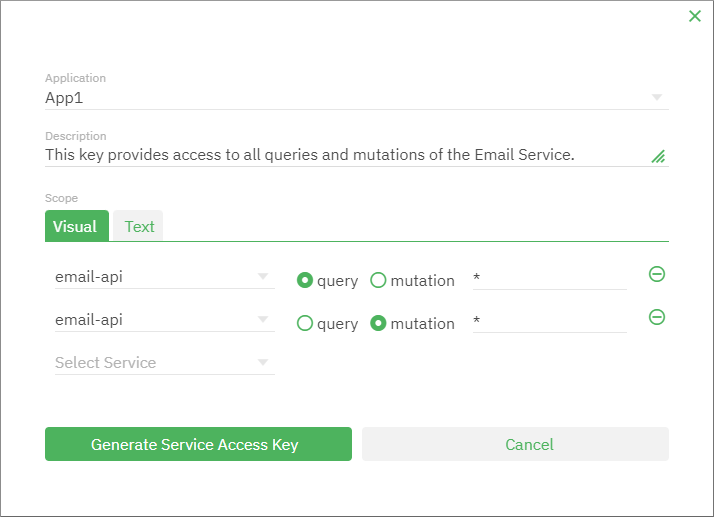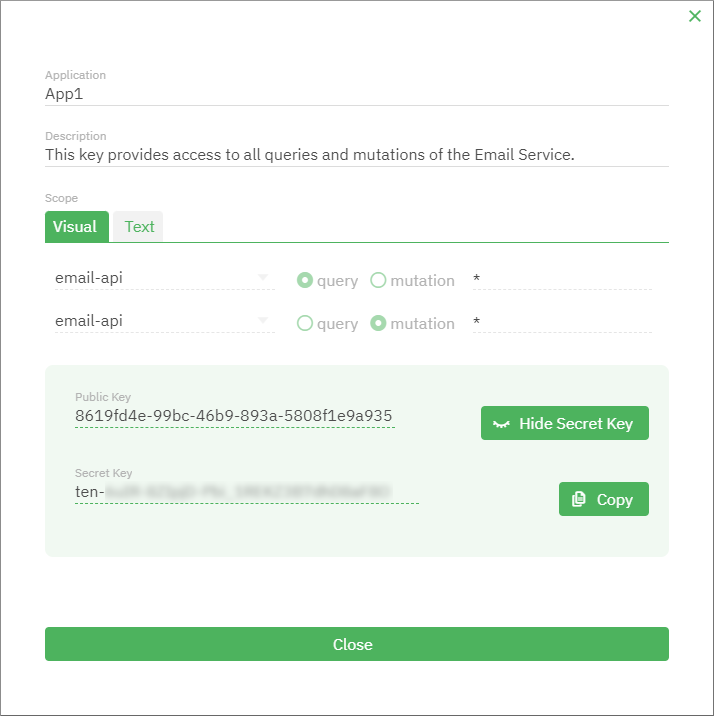Generate a service access key
Nearly all of the SBS services require authorization through a service access key (SAK).
You can generate a service access key either from the graphical user interface of the SBS Console (Web UI), or programmatically from GraphQL.
To generate a service access key, the following prerequisites must be in place:
- the application for which you are generating the key must exist in your SBS account.
- the tenant for which you are generating the key must exist in your SBS account.
For an introduction to the SBS account, application, and tenant concepts, refer to the Getting Started tutorial.
Web UI
To generate a service access key through the Web UI:
-
Sign in to the SBS Console.
-
In the left-hand side navigation menu, click Tenants.
-
Click the tenant for which you would like to generate the key.
-
Click the Add
 button in the top-right corner of the service access keys table. A dialog box appears.
button in the top-right corner of the service access keys table. A dialog box appears. -
Under Applications, select the application for which you are generating the key.
-
Optionally, enter a key description.
-
Under Scope, enter the extent of permissions available to the bearer of this key. For details, see Scope editor. Note that, if you leave the scope unset, the key bearer will be granted full access to all APIs that require a tenant-level security access key (for the selected app and tenant).

-
Click Generate Service Access Key. The key is generated and the dialog box remains open.
-
Click Show Secret Key and copy the private key value. You can now use this value in the
x-api-keyheader when accessing a relevant SBS service.
GraphQL
To generate a service access key from GraphQL:
- Sign in to the SBS Console and click the GraphQL tab. Alternatively, access the Account API programmatically from your own GraphQL development environment.
- Run the following mutation:
mutation generate_sak($appId: ID!, $tenantId: ID!, $active: Boolean, $description: String, $scope: Scope) {
generateServiceAccessKey(
input: {appId: $appId, tenantId: $tenantId, active: $active, description: $description, scope: $scope}
) {
privateKey
}
}
In the variables, make sure to replace the example values below with the ones you actually require:
appId- The unique identifier of the application for which you are generating this key. To view all applications and their details, run theappsquery first.tenantId- The unique identifier of the tenant for which you are generating this key. To view all tenants and their details, run thetenantsquery first.scope- Restricts the scope of the key to specific services only, or to even to specific queries and mutations of a service. This is also optional. Bear in mind, however, that an empty scope means that access to all queries and mutations of all services is granted. When multiple scope strings exists, they must be separated by space characters. For more information about the syntax rules, see Restrict access to services.description- An optional text description that will help you easier identify the key later.
{
"appId": "YOUR_APPLICATION_ID",
"tenantId": "YOUR_TENANT_ID",
"description": "",
"scope": ""
}
The privateKey field in the returned response contains the generated key.